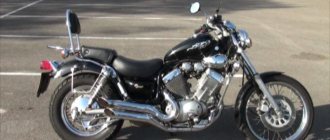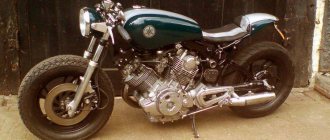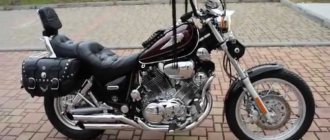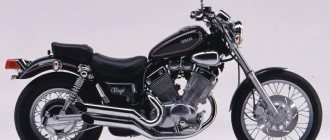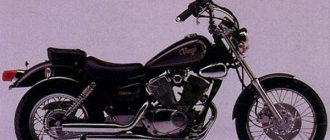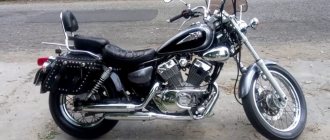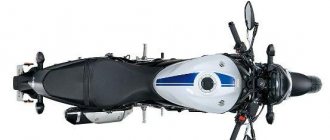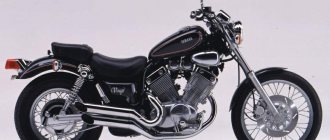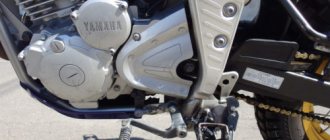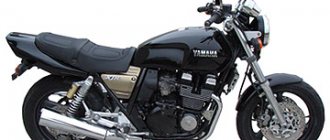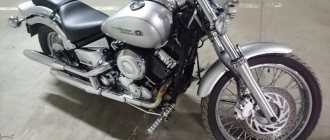| Yamaha Virago 750 (1981-1983) | Yamaha Virago 750 (1984-1998) | Yamaha Virago 750 (1986-1996) |
Yamaha XV 750 Virago cruiser model
appeared in 1981 and became the first motorcycle in the then new Virago line. The first versions of the Virago 750 looked like a classic road motorcycle, and only in 1984, having undergone restyling, the model received the well-known features of a short-wheelbase cruiser.
In 1986, the Virago 750 model received a new generation engine that produced less power. In addition, the new version of the starter system solved the problem of rapid failure of this unit, inherent in the previous generation of the motorcycle. In the same year, based on the Yamaha XV750 Virago, the Yamaha XV1100 Virago model was introduced, which was built on a new generation of engine and also had no problems with the starter.
The Virago 750 is a classic short-wheelbase cruiser in the style of the 80s and early 90s. At the same time, many modifications of the motorcycle were released, but the most popular to this day remain the 400, 750 and 1100 cc models. see. In 1998, the Yamaha XV 750 Virago was discontinued, and by 2000 the entire Virago series was finally leaving the market, giving way to more modern models of the Star series: Drag Star for Europe and V-Star for America.
The Yamaha XV750 Virago is equipped with a 2-cylinder V-shaped (75°) air-cooled engine with a volume of 748 cm³, with 2 valves per cylinder, producing up to 60 hp. power in older versions and up to 65 Nm of torque. Unlike modern cruisers, the engine was quite revvy and produced maximum performance at 6000-7000 rpm.
Other features of the Virago 750 include a steel frame (the engine is the main load-bearing element), classic suspension in the form of a telescopic fork and double shock absorber, front disc and rear drum brakes, a 5-speed gearbox, a cardan drive, a 14.5-liter fuel tank and 235 kg curb weight.
Main modifications of Virago 750:
- Yamaha XV750 Virago (frame 55R-33XXXX
) - version with spoked wheels. - Yamaha XV750 Virago (frame 55R-02/03XXXX
) - version with alloy wheels.
This classification applies to Japanese versions of the motorcycle produced from 1984 to 1988. European versions also had spoked and cast wheels - spoked versions were available up to and including 1996.
1998 was the last year of production of the Yamaha XV750 Virago model, after which it left the market and did not receive further development.
The main competitors of the Yamaha XV 750 Virago in the class:
- Honda Shadow 750
- Kawasaki VN750 Vulcan
- Suzuki VS750 Intruder / Suzuki VS800 Intruder
Brief history of the model
- 1981 - start of production and sales of the Yamaha XV750 Virago model.
Model
: Yamaha Virago 750 (USA).
Factory designation
: XV750H.
- 1982 - no significant changes.
Model
: Yamaha Virago 750 (USA, Japan).
Factory designation
: XV750J, 5K00.
- 1983 - no significant changes.
Model
: Yamaha Virago 750 (USA).
Factory designation
: XV750K, XV750MK.
- 1984 - the model receives a classic double rear shock absorber (instead of a monoshock absorber), the air filter is located not inside the frame, but outside; the tank takes on a teardrop shape, the shape of the saddle changes, and the fork offset increases. The appearance of the XV700 model for the American market (at that time the United States introduced increased duties on motorcycles with an engine capacity of more than 700 cc to support Harley-Davidson sales) with cast and spoked (on request) wheels.
Model
: Yamaha Virago 750 (Japan).
Factory designation
: 55R.
- 1986 - the model receives a new engine (4PV1 instead of 5E4) with an improved engine starter system and 55 hp. At the same time, based on the 750 version, a new model Yamaha XV1100 Virago appears. The appearance of a modification with spoked wheels.
Model
: Yamaha Virago 750 (Japan).
Factory designation
: 1RW0.
- 1988 - no significant changes.
Model
: Yamaha Virago 750 (USA).
Factory designation
: XV750U, XV750UC.
- 1989 - no significant changes.
Model
: Yamaha Virago 750 (USA).
Factory designation
: XV750W, XV750WC.
- 1990 - no significant changes.
Model
: Yamaha Virago 750 (USA, Europe).
Factory designation
: 3JL6, XV750A, XV750AC.
- 1991 - no significant changes.
Model
: Yamaha Virago 750 (USA, Europe).
Factory designation
: 3JL9, XV750B, XV750BC.
- 1992 - no significant changes.
Model
: Yamaha Virago 750 (USA, Europe).
Factory designation
: 3JLC, 4FY1, 4FY2, XV750D, XV750DC.
- 1993 - no significant changes.
Model
: Yamaha Virago 750 (USA, Europe).
Factory designation
: 3JLF, 4GK1, XV750E, XV750EC.
- 1994 - The Yamaha XV750 Virago model receives brake discs enlarged to 298 mm and a new front caliper design (parallel pistons instead of opposed) on the version with spoked wheels.
Model
: Yamaha Virago 750 (USA, Europe).
Factory designation
: 3JLJ, 4FY4, 4FY5, XV750F, XV750FC.
- 1995 - no significant changes.
Model
: Yamaha Virago 750 (USA, Europe).
Factory designation
: 3JLM, 4GK3, 4PW1, 4PW2, XV750G, XV750GC.
- 1996 - the model receives new stainless steel mirrors (rectangular chrome). The last year of production of versions with spoked wheels.
Model
: Yamaha Virago 750 (USA, Europe).
Factory designation
: 3JLR, 4GK4, 4PW3, 4PW4, XV750H1, XV750HC1.
- 1997 - no significant changes.
Model
: Yamaha Virago 750 (USA, Europe).
Factory designation
: 3JLU, XV750J1, XV750JC1.
- 1998 is the last year of production.
Model
: Yamaha Virago 750 (Europe).
Factory designation
: 3JLX.
Appearance
Yamaha XV 750 Virago is a short cruiser. This is achieved by having a higher front end than is typically found in the class. Namely, the gas tank is raised more sharply. But this does not make the motorcycle look like a chopper, because the saddle and passenger seat are made at the same height as most cruisers.
The exhaust pipe of the version, which is already considered a full-fledged cruiser, is not as elegant as that of the motorcycles of the first years of production. The alloy wheels of the new version are also inferior in style to the old one. However, in other respects, a full-fledged cruiser is no less aesthetically pleasing, it just looks a little less catchy.
Specifications
Technical characteristics of Yamaha XV750 Virago:
| Model | Yamaha XV750 Virago |
| Motorcycle type | cruiser |
| Year of issue | 1981-1998 |
| Frame | steel backbone (engine - load-bearing part) |
| engine's type | 2-cylinder, 4-stroke, V-shaped |
| Working volume | 748 cm³ |
| Bore/Stroke | 83.0 x 69.2 mm |
| Compression ratio | 8.7:1 |
| Cooling | air |
| Number of valves per cylinder | SOHC, 2 valves per cylinder |
| Fuel supply system | carburetor, 2x Mikuni BST40 |
| Ignition type | transistor TCI |
| Maximum power | 60.0 hp (44.0 kW) at 7000 rpm - XV750 (1981-1985) 55.0 hp (41.0 kW) at 7000 rpm – XV750 (1986-1998) |
| Maximum torque | 64.7 Nm (6.6 kg-m) at 6000 rpm - XV750 (1981-1985) 59.0 Nm (6.0 kg-m) at 6000 rpm - XV750 (1986-1998) |
| Clutch | Multi-disc in oil bath, cable drive |
| Transmission | 5-speed |
| type of drive | cardan |
| Front tire size | 100/90-19 (57H) |
| Rear tire size | 140/90-15M/C (70H) |
| Front brakes | 2 discs, 282 mm, 2-piston calipers – XV750 (1981-1993) 2 discs, 298 mm, 2-piston calipers – XV750 (1994-1998) |
| Rear brakes | drum |
| Front suspension | telescopic fork (non-adjustable), travel - 150 mm |
| Rear suspension | pendulum with monoshock absorber, stroke - 100 mm - XV750 (1981-1983) pendulum with two shock absorbers, stroke - 97 mm - XV750 (1984-1998) |
| Motorcycle length | 2230 mm – XV750 (1981-1983) 2285 mm – XV750 (1984-1998) |
| Motorcycle width | 850 mm – XV750 (1981-1983) 840 mm – XV750 (1984-1998) |
| Motorcycle height | 1160 mm – XV750 (1981-1983) 1190 mm – XV750 (1984-1998) |
| Wheelbase | 1525 mm |
| Seat height | 715 mm |
| Minimum ground clearance (clearance) | 145 mm |
| Acceleration 0-100 km/h (0-60 mph) | 5.8 sec[1] |
| Maximum speed | 175 km/h[2] |
| Gas tank capacity | 14.5 l (including reserve - 2.5 l) |
| Motorcycle weight (curb) | 235 kg |
History of changes
Firstly, it’s worth talking about the changes that have turned an almost road bike into a cruiser. At this time, a rear double shock absorber of the classic type is installed. They also increase the fork offset and place the air filter outside the frame.
But there were other changes:
- In 1986 the bike received a new engine.
- In 1994, the front brake discs were changed to larger ones.
- In 1996, new mirrors made of stainless steel were installed.
Otherwise, the bike has not changed during all this time. Perhaps if the car was still in production, the rear brake would have been replaced with a disc brake. However, this is not so easy to do technologically. And this is evidenced by representatives of the class, which are still produced with drum brakes, simply because they were originally designed that way.
Reviews
Reviews about Yamaha XV750 Virago:
Expand Collapse
First of all, I am satisfied with the layout of the motorcycle controls. The low seating allows you to call it relaxed. You will feel extremely confident even if you are short. Moving the footpegs forward is not quite chopper-like, but also guarantees a comfortable landing. The tidy consists of two glasses - a classic. All readings are easy and convenient to read. The only disappointment is the lack of a fuel level sensor. Well, however, instead, there is a tachometer light on the dashboard that blinks when refueling is needed. But since the tank itself is small in volume, it is not a very convenient or necessary tool.
The motorcycle is extremely pleasant to ride and control. The torque of the 750cc V-twin engine is very smooth and makes it possible to move lightly in the road space for almost an eternity... When necessary, the Virago 750 extracts its hidden reserves of dynamics. Of course, the acceleration indicators cannot be called stunning, but for ordinary movement without extreme extremes it is quite enough. The engine performs well at high speeds, but seems to be cautiously hinting - master, don’t do it)))
Here's an approximate picture of what will happen if you don't listen to the engine's hints. After the mark of 5 thousand revolutions and at a speed of at least 140 km/h, the rhythm turns into a continuous and not very pleasant vibration. Then the wind begins to mercilessly hit your chest, from which there is nowhere to escape. In a word, the chassis of the motorcycle is clearly not designed for such loads and riding modes; “jambs” are starting to slip more and more often. Don’t even think about doing such experiments on poor-quality road surfaces!
The gearbox has 5 gears and shows fairly clear operation, but is moderately noisy. The seating position is quite specific (something between a road bike and a chopper) and immediately after purchase it interfered with clear gear shifting, but over time I got used to it. So, every now and then I shuffled in the air with the toe of my left foot - I just couldn’t find the gearbox pedal. But a few hours of active running-in, and the reflexes began to fall into place.
In addition to the obedient engine, Virago pleased me with its obedient handling. At first, I was tuned to the laziness inherent in choppers when cornering and the maneuverability of a “locomotive” character. But fortunately, I was wrong - the motorcycle even stubbornly tolerated some of my excesses and experiments when cornering. The fairly long stroke of the fork absorbed bumps and other irregularities along the way with a bang. Only a pair of rear shock absorbers were a bit let down—the motz’s backside bounced unnaturally on potholes from time to time.
Well, the brakes are no good, despite all my tolerance! Before: the brackets for 2 pistons and the hard drives are simply oak, I couldn’t even stop it on the first try! Then I realized that I needed to wholeheartedly press the front brake lever with all 5 fingers - keep in mind that the reinforced brake hoses were already in place! And God forbid you do not return the device to a vertical position! The rear brake gives me more confidence, even though it is a drum brake. You just need to remember that on an uneven track the pedal will play slightly, synchronously with the rear suspension. That's all, I guess.
Comfort
The car is comfortable primarily because of its driver's seat. It is possible to travel many kilometers comfortably on this. As for the passenger seat, it is not the safest for this class. And not every passenger will fit and feel comfortable on this small bike.
On the road the bike is comfortable only at medium speeds. It is stable, like most representatives of this class, and therefore is perfect for driving somewhere on windy roads. However, initially the car is not equipped with a windshield. This cannot be called a minus, because it makes the bike look more stylish. In addition, you shouldn’t accelerate too much on such a car due to the presence of a drum brake at the rear.
What do the owners say?
From the video and photos it is clear that one cannot expect any special dynamics from the motorcycle. Many owners agree with this. They say it's a great choice for leisurely riding. It is also advised not to use the bike at full power, as this may one day end badly for both the bike and the rider.
About 105 thousand Russian rubles - that’s how much such a car costs today. Connoisseurs of the cruiser class agree that this is not much. However, from their reviews it follows that due to the lack of a new copy on the market, it remains to buy a used one. And even if you manage to buy a good car, perhaps the mileage will soon make itself felt.
In addition, unfortunately, not everyone complies with storage conditions. So even a car that has barely been used may already be in poor condition. In addition, when purchasing older models, the issue of maintenance is usually acute, and this case is no exception.
But the point here is that spare parts for this equipment are no longer easy to obtain. And sometimes they cost a lot. So it’s worth asking in advance how things are going with this in the locality where the person lives, and how much delivery will cost. However, according to the description of many owners, if desired, such a bike can be repaired and kept in good condition. However, this issue comes up in almost every review.
In conclusion, it is worth noting that the Yamaha XV 750 Virago is a good overall motorcycle, but it requires a special attitude and, so to speak, philosophy. The car is suitable for those who prefer old cruiser models with the same technical parameters and are able to use them safely for themselves and others.
